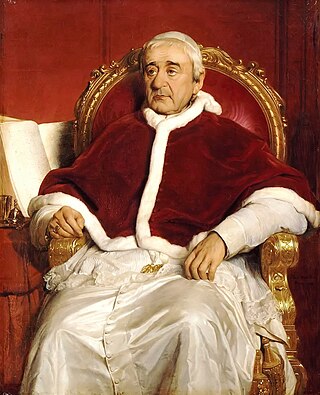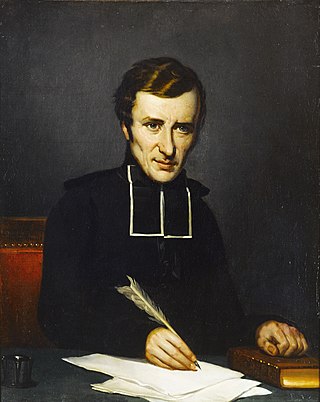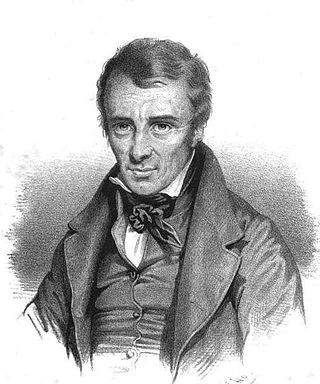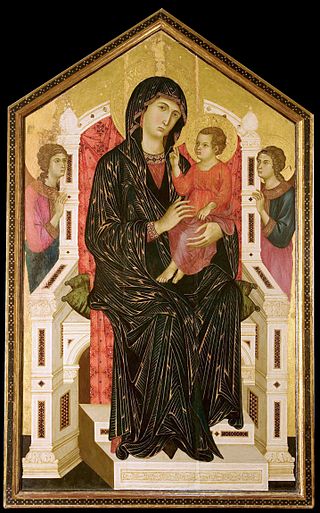
Pope Gregory XVI was head of the Catholic Church and ruler of the Papal States from 2 February 1831 to his death in June 1846. He had adopted the name Mauro upon entering the religious order of the Camaldolese.

Pope Pius VIII was head of the Catholic Church and ruler of the Papal States from 31 March 1829 to his death in November 1830.

Félicité Robert de La Mennais was a French Catholic priest, philosopher and political theorist. He was one of the most influential intellectuals of Restoration France. Lamennais is considered the forerunner of liberal Catholicism and social Catholicism.
Quanta cura was a papal encyclical issued by Pope Pius IX on 8 December 1864. In it, he decried what he considered significant errors afflicting the modern age. These he listed in an attachment called the Syllabus of Errors, which condemned secularism and religious indifferentism.
Modernism in the Catholic Church describes attempts to reconcile Catholicism with modern culture, specifically an understanding of the Bible and Catholic tradition in light of the historical-critical method and new philosophical and political developments of the late 19th and early 20th centuries.

Liberal Catholicism was a current of thought within the Roman Catholic Church influenced by classical liberalism and promoting the separation of church and state, freedom of religion in the civic arena, expanded suffrage, and broad-based education. It was influential in the 19th century and the first half of the 20th, especially in France. It is largely identified with French political theorists such as Felicité Robert de Lamennais, Henri Lacordaire, and Charles Forbes René de Montalembert influenced, in part, by a similar contemporaneous movement in Belgium.
Catholic social teaching (CST) is an area of Catholic doctrine which is concerned with human dignity and the common good in society. It addresses oppression, the role of the state, subsidiarity, social organization, social justice, and wealth distribution. CST's foundations are considered to have been laid by Pope Leo XIII's 1891 encyclical, Rerum novarum, which advocated distributism. Its roots can be traced to Catholic theologians such as Thomas Aquinas and Augustine of Hippo. CST is also derived from the Bible and cultures of the ancient Near East.

Humanum genus is a papal encyclical promulgated on 20 April 1884 by Pope Leo XIII.
The history of the Catholic Church is integral to the history of Christianity as a whole. It is also, according to church historian Mark A. Noll, the "world's oldest continuously functioning international institution." This article covers a period of just under two thousand years.
Mirari vos, sometimes referred to as Mirari vos arbitramur, was the fourth encyclical letter of Pope Gregory XVI and was issued in August 1832. Addressed to "All Patriarchs, Primates, Archbishops, and Bishops of the Catholic World", it is general in its audience and scope, whereas his three earlier encyclicals had been addressed to more specific audiences in the Papal States and the Kingdom of Poland.
Qui pluribus is an encyclical promulgated by Pope Pius IX on 9 November 1846. It was the first encyclical of his reign and written to urge the prelates to be on guard against the dangers posed by rationalism, pantheism, socialism, communism and other popular philosophies. It was a commentary on the widespread civil unrest spreading across Italy, as nationalists with a variety of beliefs and methods sought the unification of Italy.
Singulari Nos was an encyclical issued on June 25, 1834, by Pope Gregory XVI. Essentially a follow-up to the better-known Mirari vos of 1832, Singulari Nos focused strongly on the views of French priest Felicité Robert de Lamennais, who did not see any contradiction between Catholicism and then-modern ideals of liberalism and the separation of church and State.

Ineffabilis Deus is an apostolic constitution by Pope Pius IX. It defines the dogma of the Immaculate Conception of the Blessed Virgin Mary. The document was promulgated on December 8, 1854, the date of the annual Solemnity of the Immaculate Conception, and followed from a positive response to the encyclical Ubi primum.
Haurietis aquas is an encyclical of Pope Pius XII on devotion to the Sacred Heart of Jesus. It was written on May 15, 1956, to commemorate the 100th anniversary of the establishment of the feast of the Sacred Heart of Jesus by Pope Pius IX.

Deiparae Virginis Mariae, is an encyclical of Pope Pius XII released in 1946 addressed to all Catholic bishops on the possibility of defining the Assumption of the Blessed Virgin Mary as a dogma of faith.

Mariological papal documents have been a major force that has shaped Roman Catholic Mariology over the centuries. Mariology is developed by theologians on the basis not only of Scripture and Tradition but also of the sensus fidei of the faithful as a whole, "from the bishops to the last of the faithful", and papal documents have recorded those developments, defining Marian dogmas, spreading doctrines and encouraging devotions within the Catholic Church.
Ubi primum is an encyclical of Pope Pius IX to the bishops of the Catholic Church asking them for opinion on the definition of a dogma on the Immaculate Conception of the Virgin Mary. It was issued on February 2, 1849.
The theology on the body is a broad term for Catholic teachings on the human body.

Rothschild loans to the Holy See refers to a series of major financial loans arranged between the Rothschild family and the Holy See of the Catholic Church. The first loan which occurred in 1832 took place in the aftermath of the Napoleonic Wars during the Pontificate of Pope Gregory XVI. This loan agreed on was for a sum of £400,000. A second loan occurred during the Pontificate of Pope Pius IX in the early 1850s with the same members of the Rothschild family after the collapse of Giuseppe Mazzini's short-lived revolutionary Roman Republic and the restoration of the Papal States.







